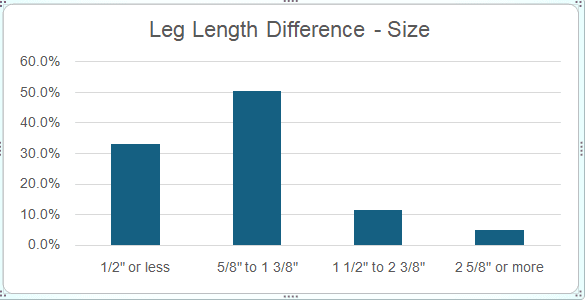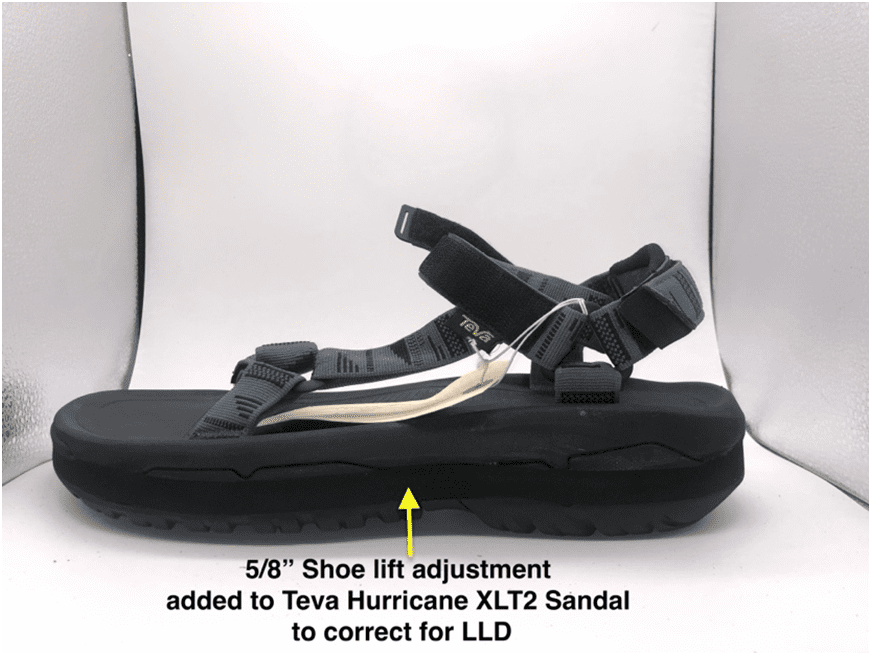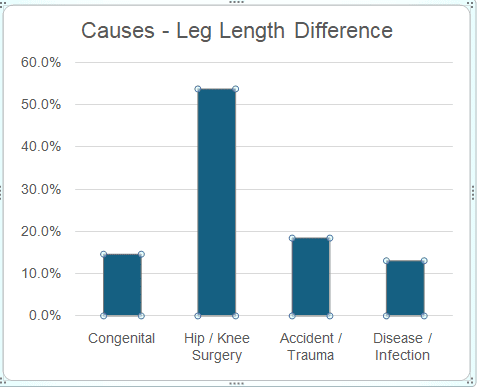Understanding Leg Length Discrepancy: Causes and Insights from American Heelers Survey
Leg Length Discrepancy (LLD) is a condition where one leg is shorter than the other, leading to biomechanical imbalances that can affect gait, posture, and overall comfort. At American Heelers, we have worked with over 20,000 patients, giving us a unique perspective and insight into the causes, facts, and treatment of LLD. To further understand the condition, we surveyed over 1,000 of our patients, compiling data to assist both doctors and patients in navigating their LLD challenges. In this case, we can break down how common different lift size ranges are in the general population.
How Common is LLD of varying sizes?
Our research found that LLD varies in severity, with lift sizes distributed as follows:
- 1/2″ or less – 33.1%
- 5/8″ to 1 3/8″ – 50.4%
- 1 1/2″ to 2 3/8″ – 11.4%
- 2 5/8″ or more – 5.1%

This data shows that most individuals with LLD fall within a moderate range of just over ½” to just under 1 ½”, requiring specific accommodations to enhance mobility and reduce discomfort. In our expertise any LLD over 3mm is best addressed with shoe lift modification as opposed to using shoe lift insert inside of the shoe under the foot. The reason for this is that when you use an insert inside of a shoe larger than 3mm (1/8”) that causes the space inside the shoe to be crowded, and the foot sits awkwardly inside causing pain, blisters, discomfort, and even musculoskeletal imbalances leading to pains up and down the body. This can create new complications that otherwise were not there. By modifying the shoe sole, the patient can have their LLD addressed seamlessly and walk normally.

What Causes Leg Length Discrepancy?
LLD can arise from various factors, broadly categorized into congenital, surgical, traumatic, and disease-related causes. We surveyed over 1,000 of our customers and broke them down into groups. This information can give comfort to patients and insights to doctors who are diagnosing leg length differences in their patients.

Congenital Causes (14.6%)
Some individuals are born with conditions that lead to uneven leg growth, including:
- Congenital Hemihypertrophy – One side of the body grows larger than the other.
- Congenital Hemiatrophy – The underdevelopment of one side of the body.
- Clubfoot – A birth defect where the foot is twisted, potentially leading to LLD.
- Neurofibromatosis – A genetic disorder that affects bone growth.
- Ollier’s Disease – A condition characterized by benign cartilage tumors that disrupt normal bone growth.
Surgical Causes (53.8%)
A significant portion of LLD cases arise after hip or knee surgeries. Procedures such as hip replacements and knee reconstructions can sometimes result in minor or major discrepancies due to surgical technique, prosthetic positioning, or post-surgical healing complications. As much as most surgeons hate to admit this cause, in many surgical procedures, one slight miscalculation by the surgeon can cause the patient to have a leg length difference post-surgery. We hear this day in and day out.
Accident/Trauma (18.5%)
Fractures, especially those affecting growth plates in children, can lead to uneven bone growth. Severe accidents causing damage to bones or joints may also result in LLD over time. Motorcycle and car accidents are a very common cause of this.
Disease/Infection (13.1%)
Certain diseases can cause bone damage or disrupt normal growth, leading to LLD. Some of the most common disease-related causes include:
- Polio – Can lead to muscle weakness and bone deformities.
- Bone Tumors – May require surgical intervention, affecting bone length.
- Perthes Disease – A childhood hip disorder that impacts bone development.
- Osteomyelitis – A severe bone infection that can affect growth.
- Rickets – A disorder caused by vitamin D deficiency, leading to bone softening and deformities.
- Spina Bifida – A neural tube defect that can cause musculoskeletal imbalances.
How American Heelers Helps
Understanding the cause of LLD is crucial for diagnosing leg length differences and finding the best solution for them. At American Heelers, we specialize in custom shoe modifications to help individuals regain balance and comfort in their daily lives. Whether your LLD is congenital, or the result of surgery, trauma, or disease, we offer expert solutions tailored to your needs.
If you or a loved one is dealing with LLD, reach out to us today to explore our custom shoe lifts and other solutions. With years of experience and thousands of satisfied customers, we are committed to improving mobility and quality of life for those affected by LLD. We also offer our services worldwide through the mail; by not selling shoes, we don’t limit the customer to a specific shoe, the customer selects the shoes that already fit them well, and then through our easy mail-in process, the shoes are sent into us for the adjustment and then sent back to the patient in a week or less.
American Heelers
24000 Mercantile Rd. #14
Beachwood, OH 44122
216-378-2686
